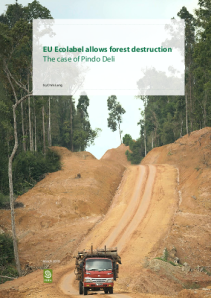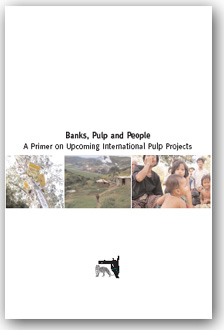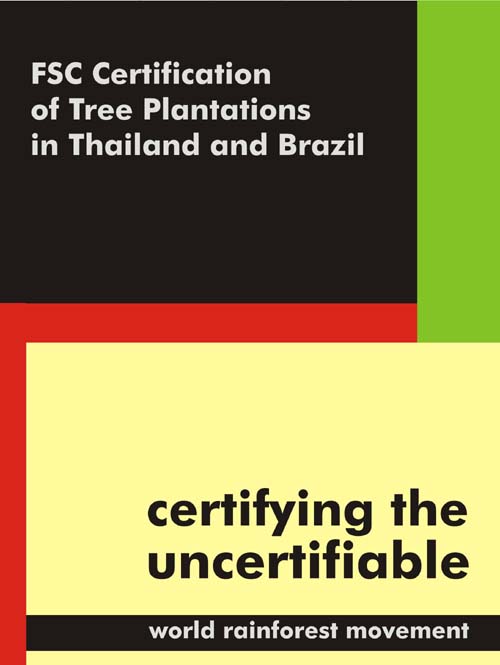The paper industry claims to be addressing climate change. It isn’t. It’s making things worse.
By Chris Lang. Published in WRM Bulletin 125, December 2007.
For many years, the pulp and paper industry has been trying to paint itself green. No challenge is too big, it seems, for one of the most polluting industries on the planet. Although paper production is a major consumer of energy and a major cause of greenhouse gas emissions, the latest challenge for the industry is to go “carbon neutral”. While reducing greenhouse gas emissions may sound like something that we all welcome, this industry-dominated discussion sidesteps the fact that the pulp and paper industry is expanding rapidly, especially in the global South. It also ignores the issue of massive overconsumption of paper in the North. The best way of reducing the impact of the pulp and paper industry is by reducing the amount of paper produced. But of course the paper industry isn’t interested in talking about this.
In October 2007, the Forest Products Association of Canada (FPAC) announced that by 2015 it would become Canada’s first “carbon-neutral” industry. The announcement came during a conference at a luxury five-star hotel in the centre of Ottawa. Featuring key note speeches from Keith Trent of Duke Energy and Clive Mather, CEO of Shell Canada, the conference was titled, appropriately enough, “The Business of Climate Change Conference”.[1]
FPAC has entered into a partnership with WWF to “help guide the initiative”. FPAC claims to have already reduced its greenhouse gas emissions by 44 per cent between 1990 and 2004.[2] But this figure of 44 per cent reduction in emissions is a fraud. It excludes so-called “indirect emissions” – emissions produced in generating the electricity which the industry uses.
A 2005 report includes both direct and indirect emissions and concludes that the forest sector’s greenhouse gas emissions in 2002 were the same as they were in 1980. The report, produced by the Canadian Council of Forest Ministers, notes that the forest sector is the “largest single industrial energy user in Canada and has significant GHG [greenhouse gas] emissions”.[3]
Another more recent report produces data indicating that the situation may be even worse. This report was commissioned by the FPAC, giving the industry little excuse to ignore it. Written by the National Council for Air and Stream Improvement (NCASI), the report compares emissions in 1990 with those in 2005. The report calculates direct emissions from manufacturing, “indirect” emissions from electricity generation, transport emissions and methane produced from forest products in landfills. In 2005, according to NCASI, the forest industry was responsible for a total of 53.3 million tonnes of carbon dioxide equivalent, compared to 49.7 million tonnes in 1990 – an increase of 7.2 per cent.[4]
But the NCASI report doesn’t stop there. It introduces some creative accounting in the form of “sequestration” and “avoided emissions”, giving the impression that things are not as bad as they appear and in any case may soon get better. “Available data demonstrate that GHG emissions along the forest products industry value chain are largely offset by sequestration accomplished in forest products,” writes NCASI.[5] Methane emissions from rotting paper and other forest products in landfills are the largest single source of greenhouse gases from the Canadian forest industry, accounting for about 46 per cent of the industry’s greenhouse gas emissions in 2005. NCASI reassuringly explains that, “landfill methane emissions attributable to Canadian forest products are more than offset by net storage of carbon in forest products deposited in landfills.”[6] Some forest products in landfill sites rot quickly and release methane, others rot more slowly, releasing methane more slowly. This, according to NCASI is “sequestration”.
“Avoided emissions”, meanwhile, are changes that the industry could make, such as producing more recycled paper or using combined heat and power generation. The fact that the industry could also avoid emissions by producing less paper isn’t mentioned in NCASI’s report. Instead, NCASI anticipates an increase in consumption of forest products.[7]
In September 2007, the Confederation of European Paper Industries (CEPI) published a Carbon Footprint Framework. CEPI does not make any grand claims about the industry becoming “carbon neutral”. Instead, the Carbon Footprint Framework presents a series of arguments that companies can use to convince consumers that their product is “carbon neutral”. Not surprisingly, CEPI’s arguments are similar to those of its Canadian counterpart. For example, CEPI proposes that the industry should argue that carbon is sequestrated in both forests and in paper products: “Use the statement that Sustainable Forest Management (SFM) ensures that carbon stocks in forests stay stable or even improve over time and build on this statement.”[8]
Part of the reason that paper consumption is increasing is because paper companies are constantly coming up with new uses for paper and promoting ways of using more paper. When these paper products end up in landfills, they rot and produce methane. Rather than attempting to greenwash its activities with spurious arguments about carbon sequestration, the pulp and paper industry should stop producing rubbish.
References:
[1] The “Business of Climate Change” website is here.
“Canadian Forest Products Industry Aims to be First Carbon-Neutral Sector“, FPAC Press Release, 30 October 2007.
[2] “Climate Change“, FPAC’s website.
“Canada’s Forest Industry: Setting the Record Straight“, Forest Ethics, 2007.
[3] “Criteria and Indicators of Sustainable Forest Management in Canada. National Status 2005. Indicator 4.1.4 – Forest sector carbon emissions“, Canadian Council of Forest Ministers.
[4] “The Greenhouse Gas and Carbon Profile of the Canadian Forest Products Industry“, Special Report No. 07-09, National Council for Air and Stream Improvement, 2007.
The figures cited above are from page 21. In the abstract of the report, NCASI rounds off the numbers, making the situation look slightly better for the forest industry.
[5] “The Greenhouse Gas and Carbon Profile of the Canadian Forest Products Industry“, Special Report No. 07-09, National Council for Air and Stream Improvement, 2007, page 24.
[6] “The Greenhouse Gas and Carbon Profile of the Canadian Forest Products Industry“, Special Report No. 07-09, National Council for Air and Stream Improvement, 2007, page 22.
[7] “The Greenhouse Gas and Carbon Profile of the Canadian Forest Products Industry“, Special Report No. 07-09, National Council for Air and Stream Improvement, 2007, page 23.
[8] “Framework for the Development of Carbon Footprints for Paper & Board Products”, CEPI, September 2007, page 5.










All interesting and true, but why on Earth wouldn’t the paper industry try to get people to use more paper? If they are like every other industry in existence, their managers are paid bonuses based on performance, which is based on stock price and profits, which are based on selling more paper. It makes perfect sense for the paper industry to greenwash their industry, especially if this undercuts public interest in altering their behavior through legislation. I’d like to say that the simple answer to this is to push for legislation anyway, but I have little doubt that the industry has a second line of defense in lobbying any legislation down to ineffectiveness (or if they really do their job, turning it into a flat subsidy, as per the German steel industry), and a third line of defense in exploiting the loopholes in any limits that remain.
Let’s also note in passing that making less paper also involves laying off people in the logging and paper industries. That’s never popular with politicians, and of course is even less popular with the people losing their jobs, and the people whose jobs depend in turn on the people who will lose their jobs…
No, I don’t know what the answer is. I think we will have to wait for things to get a whole lot worse.